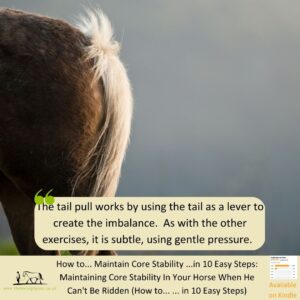If you prefer watching or listening, please click on the video above. If you like reading, please keep scrolling. Please subscribe to The Horse Physio newsletter, and follow, like and share me on the social media channels that you enjoy the most (you can find links to each channel at the bottom of this page). Your support is important to me and enables me to continue producing content to help you and your horse.
Taken from the book ‘How To Maintain Core Stability In 10 Easy Steps: Maintaining Core Stability In Your Horse When He Can’t Be Ridden’, available for just £1.99 on Kindle (or free if you have Kindle Unlimited).
Please be aware that this blog includes affiliate links. By buying a product at no extra cost to yourself, you can help support me in writing more blogs about healthier, happier horses and handlers.
One of these days, I will figure out how to draw on my computer to illustrate the exercises in this book. I will also make the time to film the exercises and add them to my series of online courses. For now, I’m simply going to do my best to explain the principle to you. If I wait until I’ve got everything how I want it, I’ll never get there.
Wither rocking is one of my favourite exercises to do with the horses I treat. I think I go into a kind of trance. It seems that the horses do as well, judging by their expressions. It’s a bit like rocking my son when he was a baby. Now that he’s older, he complains a lot if I try to pick him up and rock him! I find a rhythm, and my whole body moulds with it. That way, it doesn’t stress my arms or shoulders too much. I know when the horse’s muscle tension releases because I can feel the change in the movement.
There are two parts to this exercise. You can do one or both.
Both of these rocking movements will feel easy and relaxing, for you and your horse when you get them right. Enjoy!
A cautionary note first of all – please stay safe! This guide is written in good faith that you will assess whether or not each exercise is appropriate for you and your horse. I do not accept responsibility for accident or injury, howsoever caused. Standing behind your horse puts you in a high-risk zone. Touching and lifting the tail can cause sudden and extreme reactions in some cases. You know your horse. Please be careful.

“The tail pull works by using the tail as a lever to create the imbalance. As with other exercises, it is subtle, using gentle pressure.”
A lot of core stability exercises are about moving the horse slightly off balance so that he needs to engage his muscles to maintain that balance. The tail pull works by using the tail as a lever to create the imbalance. As with the other exercises, it is subtle, using gentle pressure. There should be no discomfort involved, and you should find that your horse relaxes into the exercise after a minute or two. If he doesn’t, perhaps this isn’t the right exercise for him. A horse who is uptight will not be engaging his muscles effectively. He will be tensing those movement muscles getting ready to run, rather than using the stability muscles.
If your horse clamps his tail down, this exercise is even more important, as long as you and he are both safe.
There are two exercises included in this chapter – pulling the tail backwards, and pulling the tail to the side.
How long can you stand on one leg? How about if someone gently pushes you off balance?
If you try standing on one leg, you’ll feel how many muscles the exercise engages. In particular, it causes the proprioceptive nerves around your foot and ankle to fire. These are the nerves that tell your brain where your body is in space. They cause your muscles to make very quick adjustments to your balance when needed.
Clearly, we can’t get our horses to stand on one leg. We can get them to stand on three legs rather than four, though. And we can move them off balance while they are on three legs. As with all the other exercises, we do this very gently. We don’t want them to shift their feet, we just want the muscles to engage that help them to keep their balance.
For this exercise, pick your horse’s foot up as usual. Let’s start with a front foot, say the left fore. Pick up the left fore, then place your hand under the fetlock. This way, the fetlock can stay relaxed. It can be uncomfortable for your horse if his fetlock stays bent for too long.
Gently rest your shoulder against your horse’s shoulder. Make sure you’re standing securely yourself so that you don’t wobble over! Slowly and carefully, lean into his shoulder to push more of his weight onto his right fore, then gradually release and let his weight rock slightly back towards you. Repeat. Remember, his other three feet should stay firmly on the ground. It’s a slight weight shift, not a foot-moving exercise.
Put the left fore down, and move to the right fore. Then do a similar exercise with each hind foot. Your horse will find it more difficult to balance on one hind foot than he does on one front foot, so be especially gentle when you are leaning into his hip.
You and your horse will probably find this exercise physically harder work than some of the others, so I’d suggest spending less time on this one. If your horse struggles with it, perhaps because he isn’t comfortable holding his leg up for a period of time, then leave this exercise out and focus on the ones that work better for him.
If you’d like to read more of ‘How To Maintain Core Stability In 10 Easy Steps: Maintaining Core Stability In Your Horse When He Can’t Be Ridden’, you can get your copy here on Kindle for just £1.99. With an Amazon review rating of 4.9 stars, you can’t go wrong!

Sue Palmer MCSP, aka The Horse Physio, is an award-winning author, educator, and Chartered Physiotherapist. Sue specialises in understanding the links between equine pain and behaviour, focusing on prevention, partnership and performance. She promotes the kind and fair treatment of horses through empathetic education, and is registered with the RAMP, the ACPAT, the IHA, the CSP and the HCPC.
To arrange a phone call or online coaching session with Sue Palmer, The Horse Physio, click here.
For news, views, and exclusive deals, please subscribe to our free newsletter. Your support is important to us, and helps us to continue to create content to help you and your horse.
You can find The Horse Physio on the web, on Facebook, on Instagram, and on YouTube, book an online consultation, or take a look at Sue’s online courses.
Horse Health Check: The 10-Point Plan for Physical Wellness
Head to Hoof: An Introduction to Horse Massage
Horse Massage for Horse Owners
Stretching Your Horse: A Guide to Keeping Your Equine Friend Happy and Healthy
Kissing Spines In Horses: Preventive Measures and Long-Term Management Solutions
Harmonious Horsemanship, co-authored with Dr Sue Dyson
Understanding Horse Performance: Brain, Pain or Training?
Horse Massage for Horse Owners
Thank you for your interest in this post; I appreciate your time and am grateful you chose to spend it with me. If you found value in this article, please support me by liking, subscribing, following, and sharing it on your favourite social media platform, and turn on the relevant notifications for future content from The Horse Physio. Please also take a moment to subscribe to my newsletter. Your support means the world to me, and it helps me continue creating content that matters to you.